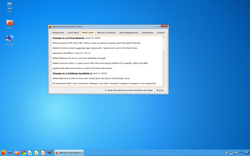Review: Kumander Linux 1.0
It has been over a decade since I have used Windows with any degree of regularity and two decades since I used the operating system at home. For this reason, I tend not to gravitate toward Linux distributions which try to look or act like Microsoft's operating system. I don't have anything against them, but resembling Windows isn't a selling point for me the way it would be for someone in the process of migrating from Windows to Linux. Projects like Zorin OS, for example, I admire as good options for Linux newcomers, but they don't hold a special appeal for me based on their appearance.
With that said, I really liked Kumander's user interface. I liked the soft blue shades, I liked the high contrast text fonts, I liked the lack of distracting visual effects. I especially liked how unusually fast and responsive the desktop was. Xfce usually performs well, and it was running at top speed during my trial, even in a virtual machine. This allows Kumander to run circles around other distributions I've used recently, such as Debian or Ubuntu running GNOME and openSUSE running KDE Plasma. In short, Kumander offers some of the visual design benefits of Windows 7 while doing away with the distracting visual effects, annoying pop-ups, and mass of background services which often make using that operating system unpleasant.
There are a few bugs. Kumander just hit its first stable release so things like the task manager shortcut not working or the timezone being set improperly are small issues which are to be expected. They're small issues and not critical. The one big issue I ran into was GNOME Software not being to install updates and there not being an easy way to fetch security patches from a GUI application. This is a significant problem and will hopefully be addressed with a dedicated update manager or a fix for the software centre in the next release.
There are some design choices I have mixed feelings about. Having some configuration modules in the application menu and others in the settings panel feels a touch disorganized. Allowing users to run admin tasks without a password feels on-brand for a distribution trying to imitate Windows, but it's not a feature I feel good about. Then again, I'm not the target audience and many users will probably appreciate this characteristic.
For a first stable release, Kumander is doing a lot of things well. It's fast, stable, and achieves its goal of being Windows like (in a good way) without most of the negative aspects of using Microsoft's product. There are some issues to work out, but few serious problems.

